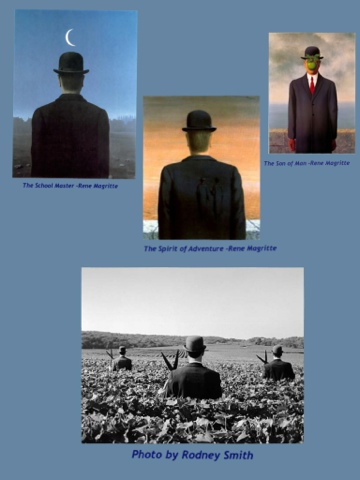Artists learn from other artists. Each generation stands on the shoulders of it's predecessors, reaching a little farther, discovering a little more. Looking at great art will enable you to create more insightful and interesting work, in the same way that reading great literature will make you a better writer. The more ideas you are exposed to, the more ideas you will develop. In this post you will learn how artists blossom; by copying what inspires them and in the process, discovering something new.
"It’s not where you take things from-it’s where you take them to."
-Jean-Luc Godard
Marcel Duchamp, Nude Descending a Staircase, No. 2, 1912

Left: Hiroshige: "Great Bridge, Sudden Shower at Atake"
Right: Van Gogh, "The Bridge in the Rain"
Claude Monet also loved Japanese art
(and Hiroshige's prints):
This Hiroshige woodblock print
inspired Monet to build this:
...and paint this:
Monet's iconic painting of the Japanese foot bridge, over the water lily pond in his garden, inspired the contemporary graffiti artist Banksy to create this:
The Great Wave off Kanagawa by Katsushika Hokusai, 1829
Chris Jordan
Gyre, 2009
To learn more about Hokusai visit the Hokusai Museum by clicking the link below:
Here are some more examples of great artists copying the work of other artists (and in the process discovering something new).
Left, Self portrait by Norman Rockwell, right, Self Portrait, cartoonist unknown
Hieronymus Bosch's mysterious painting The Garden of Earthly Delights has inspired many artists throughout the ages, from the late medieval and early renaissance painters, Bosch's contemporaries, to 20th century surrealists to modern animators working today.
Let's take a look at the painting:
After exploring The Garden of Earthly Delights, check out this animation from the 1980's by contemporary artist Aurelio Voltaire:
Pieter Bruegel The Elder, 1525-1569, was heavily influenced by Bosch. Below is his painting 'Fall of the Rebel Angels'. Compare the imaginary monsters in Bruegel's painting to the one's in Bosch's triptych:
Compare The Triumph of Death, by Pieter Bruegel The Elder, to the right hand panel of 'The Garden of Earthly Delights', depicting Hell:
To learn about how this 1937 photograph by an anonymous photojournalist inspired one of the best known and most influential paintings of the 20th century, click here.
Picasso consistently refused to discuss his influences or the symbolism hidden within his most famous painting. Compare these pictures and draw your own conclusions:
While Michelangelo's Madonna appears serene, Picasso's mother personifies agony and grief.
How was he able to capture such emotion with just a few simple lines?
Inspired to expose the atrocities in Spain and driven by the powerful images of Christ's suffering from his Catholic upbringing, Picasso was also haunted by the the childhood loss of his beloved little sister:
As an adult, Picasso sited the story of his sister's death as an influence on his art:
Synthesizing these experiences into a single painting, Picasso was able to create a piece of art that resonated with audiences throughout the world, putting a human face on the atrocities of war.
To learn more about Guernica and it's significance in our cultural history, click on the link below:
Picasso, classically trained in art, also uses the compositional structure of Guernica to pay homage to Michelangelo's Pietà:
Trace your finger over the picture to discover all of the the triangles in the layout of Picasso's famous mural. Look for shapes and lines as well as incidences where objects are piled on top of each other to form a visual pyramid.
Historians believe that Picasso deliberately chose a black and white color scheme in homage to the newspaper reporters and photojournalists on the scene covering the story. Picasso would not confirm or deny the existence of any of this symbolism, preferring to let his painting speak for itself. Art experts disagree about many of the symbols in this famous work of art.
 |
| Picasso refused to confirm or deny any of the symbolic imagery in Guernica. He wanted his anti-war statement to speak for itself. What symbols can you find when you examine this painting? |
To learn more about what art historians see when they look at Guernica click on these links:
https://www.khanacademy.org/humanities/art-history/art-1010/early-abstraction/cubism/a/picasso-guernica
To take a look at how Picasso's art was transformed by personal experience, the work of his predecessors and the world around him, let's compare an early self portrait, created a year after his sister's death, to a self portrait he painted just five years later, at age 19.
How important was Van Gogh's 'discovery' that color could consciously be used not just to depict mere reality but to express emotion? These old Prozac adds from the 1990's owe a debt of gratitude to expressionist art. I find them to be a fascinating study of the connection between color and emotion.
Here is a great website that explains how designers and advertisers use color to evoke specific emotional responses:
To learn more about the Nazi's war against modern art, click on the link below:
 |
| LEFT: Pablo Picasso, 'Head of a Woman', 1907 (oil on canvas) RIGHT: Dan Mask from West Africa |
Head of a Woman by Pablo Picasso and an African mask shown side by side. Here you can see how the African mask clearly influenced Picasso to start experimenting with simplifying the human head into planes shapes and lines. These experiments would eventually lead to the development of cubism.
Eric Testroete, video game designer,
Self-Portrait 2009.
Notice how similar Testroete's geometric lines are
to Picasso's lines in this sketch of Paul Eluard from 1941

























































Thank you for taking the time to put together this post. I know I am coming to it late, but I found it both informative and inspiring :).
ReplyDeleteThe idea of imitation was a sudden to my mind, searched it online and found this post. Thank you for putting so much effort, the information provided is clear , concise and inspiring.
ReplyDeleteI'm not a painter but i'll use the concepts in my music work .